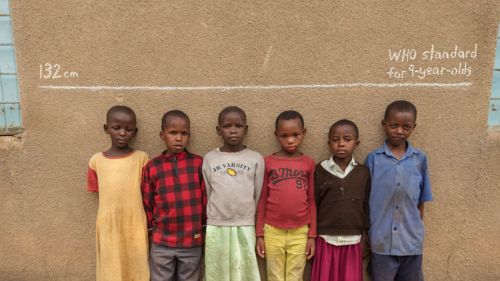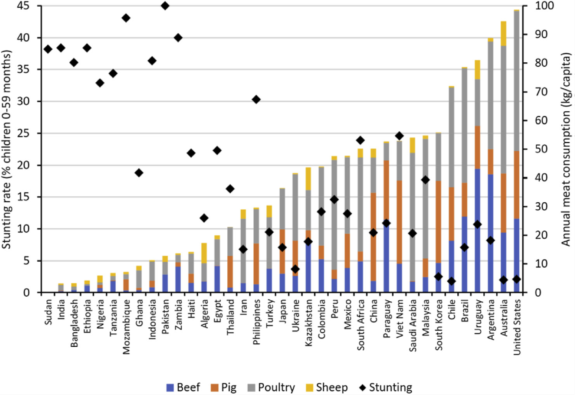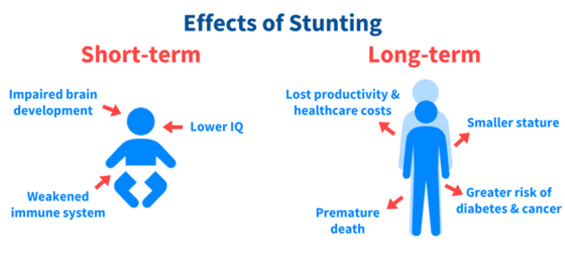To Meat or Not to Meat: Balancing Global Views in Battles over Food

Two billion people in the Global South suffer from micronutrient deficiencies due to failures in providing adequate nutrition.
Field Notes
The Chicago Council is pleased to launch a new blog series, “Breaking Ground,” to explore how food systems innovation and agricultural research and development can empower farmers and feed the world. A special subsection of this series, “Field Notes,” features voices from Feed the Future Innovation Labs and CGIAR centers.
Introduction
A child who grows up near a US supermarket has a completely different experience with food than a child who grows up near a goat in an African or Asian village. The first child and her family experience seemingly endless choices and combinations of foods and supplements to meet their needs for nourishment, whereas the child near a goat experiences poverty and scarcity. In her diet, there are few types of food and few alternatives. Goat’s meat and milk may be the only sources of many essential nutrients in her village.
A child who grows up near a US supermarket has a completely different experience with food than a child who grows up near a goat in an African or Asian village. The first child and her family experience seemingly endless choices and combinations of foods and supplements to meet their needs for nourishment, whereas the child near a goat experiences poverty and scarcity. In her diet, there are few types of food and few alternatives. Goat’s meat and milk may be the only sources of many essential nutrients in her village.
The girl of Many Foods—let’s call her Amy—has access to a plethora of eye-catching meat and milk alternatives. The girl of Few Foods—let’s call her Amina—does not. She probably lives in the Southern hemisphere and very likely suffers from undernutrition. Both girls deserve attention in today’s debates about what people should be eating. Regrettably, the Aminas of the developing world are often forgotten in the sustainability debates in high-income countries.
Thinking about goats is a good starting point, because goats are a common denominator across much of the Global South. For tens of millions of families, goats are a source of income and security, milk and meat, survival and resilience. In these parts of the world, goats and other livestock are not cute accessories for a yoga class or pets; they are necessities. The goats scour the landscape and eat weeds and brambles otherwise inedible by humans, and they transform them into animal-source foods. Goats help keep Amina alive.
Mothers and Milk
Little Amina and Amy are as cute as can be, they both need and deserve nutritious food. What can we do to support them? In theory, Amina has the same potential as Amy—unless Amina’s mother is also a woman of Few Foods. Nutrients from the pregnant or lactating mother are passed on to the child, and research tells us that the first 1,000 days of life, from conception to age two, represent the most essential window of development. Therefore, one way to support children at risk of under-nutrition is to support and educate their mothers to ensure they are well nourished.
What else can be done to help the Aminas of the world reach their potential? Fortunately, some simple adjustments to diets may be helpful. Mother’s milk is the ultimate superfood, and after six months, mothers should be encouraged to continue feeding infants and toddlers milk from cows or goats. This recommendation is a relatively straightforward prospect for families that own livestock. But there is a catch. People like Amina’s parents may make an economic decision to sell their milk instead of consuming it. It may provide one of their few sources of income, and with that money they can pay for important items like hospital bills and school fees while relying on high-calorie starches to fill their stomachs cheaply. In many cases, selling the milk and purchasing staple grains may be the only way for families to feed themselves, independent of any other items or services they might wish to buy. Unfortunately, cheap starches do not a nutritious meal make.
Desperate families in these situations may need an incentive, educational or otherwise, or a nudge to change their behavior patterns and their eating habits. Here is where a nation’s policy matters; for example, a program in Rwanda called Girinka has promoted a “one cow per family” policy. This provision gives needy families a starting point to obtain more milk.
Eggs and Growth
Another promising solution to the issue of undernutrition is the incredible, edible egg. In villages of the West African country of Burkina Faso, one of the world’s poorest nations, our researchers are conducting studies to promote egg consumption among infants and toddlers. The research is supported by the Feed the Future Innovation Lab for Livestock Systems, based at the University of Florida (with funding from USAID and the Bill & Melinda Gates Foundation). In less than a year, the children’s mothers have become vocal advocates of the project—in French known as Un Oeuf (One Egg)— and they even have a theme song. Mothers are reporting that their children are growing stronger than before they started eating eggs, and there is data to back their perceptions.
This study builds on a 2015 randomized control trial in Ecuador that had amazing results. By adding one egg a day to the diets of children aged 6-9 months, the trial led by Dr. Iannotti at Washington University in St. Louis saw stunting, a condition that cripples growth and cognitive development, reduced by 47 percent and underweight by 74 percent. This achievement is remarkable for its efficacy and its simplicity. While some efforts to replicate the incredible findings in Ecuador have fallen short, the findings of our work in Burkina Faso underscore the possibility of improving the lives of children like Amina with a simple daily egg and thus should give us hope.
Coming Up Short
Still, the global scourge of undernutrition is shameful in today’s world of abundance. Stunting, or low height for age, affects 1 in 5 children under the age of 5 globally—and rates are far higher in the developing world. These undernourished, 150 million children suffer lifelong effects from poor cognitive and physical development. Those children like Amina, concentrated in Sub-Saharan Africa and South Asia, are consequently kept from reaching their full potential and from becoming fully productive global citizens.
Undernutrition contributes to nearly half of all child deaths globally. Even the fetus can experience stunting, and this problem reinforces the importance of a high-quality diet for pregnant and lactating women. At the other end of the spectrum, elderly people may tend towards undernutrition due to changes in the efficiency of their bodies’ metabolism.
Unfortunately, simply getting more calories into these needy bodies is not enough. Starchy, high-calorie diets are common in low-income countries, but these monotonous diets are low in nutrients. Commonly missing are iron, iodine, zinc, vitamin A, and vitamin B12, the last of which is only naturally available in animal-source foods. All of these nutrients are more concentrated and bioavailable in animal-source foods, making them even more critical in the diets of infants and young children who need readily available nutrients for their small stomachs.
Meat and Brain Development
More research is needed to confirm what initial studies are showing about children who eat meat. An intervention with schoolchildren in Kenya gave them small amounts of milk or meat, and their cognitive test scores increased by 28 percent and 45 percent respectively. A 2019 review of many studies for both children and adults showed that diets including animal-source foods, versus diets dominated by other foods or unsupplemented with animal-source foods, increased test scores substantially.
At the country-level, stunting is very low in places where meat consumption is relatively high (see Figure 1). Although this association has other contributing causes, it supports the hypothesis that the nutrients in animal-source foods are important for child growth.

Figure 1: This figure first appeared in: Adesogan, A., S. McKune, Eilitta, M., Havelaar, A., and Dahl, G. 2019. Animal source foods: sustainability problem or sustainability and malnutrition solution? Perspective matters. Global Food Security.
The Global Concerns
Opponents of eating meat and other animal-based foods argue that their environmental impacts are unacceptable in the era of climate change. Certainly, the livestock and agricultural sectors globally must account for their impacts, and we must find ways to raise nutritious foods in ecologically responsible and sustainable ways. In support, a recent breakthrough showing that most of the greenhouse gas emissions from livestock can be reduced by feeding them seaweed is encouraging. Nevertheless, we must not allow discourse and dialogue on the effects of high consumption (and not just of meat) in high income countries to blind us to the basic needs of innocent, individual children, many of whom are living in the low and middle income countries.
In 2016, food from livestock provided 25 percent of protein and 18 percent of calories consumed globally, but many people in the Global South consume much, much less than this average. This form of nutrition poverty means that they need to eat more meat, eggs, fish and milk to achieve adequate levels of nutrition, because alternative sources of the nutrients like fortifiers and supplements are typically not available or accessible.
While we may identify more closely with the experience of Amy, the girl of Many Foods, let us not ignore the reality of Amina, the girl of Few Foods. Amina’s situation is frustratingly common in a world that produces great quantities of food.
Despite this global abundance, we are failing to provide adequate nutrition to the two billion people who suffer from micronutrient deficiencies in the Global South. We are failing 20 percent of all children under the age of five who are stunted. Tens of millions of families are undernourished.
As the world’s population grows and the future of food grows increasingly complex, let us not forget that producing calories is not enough. We must strive to provide food with the proper nutrition that meets the needs of all the Amys and the Aminas of the world.

Credit: World Food Program USA
To learn more about these issues, read this article from the International Livestock Research Institute on “Inalienable imperative—More, and more sustainable, meat, milk, eggs and fish for more than one billion people.” It links to and explores the article: Adesogan, A., S. McKune, Eilitta, M., Havelaar, A., and Dahl, G. 2019. Animal source foods: sustainability problem or sustainability and malnutrition solution? Perspective matters. Global Food Security. https://doi.org/10.1016/j.gfs.2019.100325